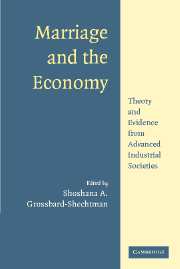Book contents
- Frontmatter
- Contents
- List of Figures
- List of Tables
- List of Contributors
- Foreword
- Acknowledgments
- Marriage and the Economy
- 1 Marriage and the Economy
- PART I THE ECONOMICS OF MARRIAGE AND DIVORCE
- 2 The Economics of Marriage and Household Formation
- 3 The Economics of Divorce
- 4 The Effects of Public Policy on Marital Status in the United States
- PART II EFFECTS OF MARRIAGE ON INCOME USES
- PART III EFFECTS OF MARRIAGE ON TIME USES
- PART IV MARRIAGE AND THE MACROECONOMY
- Index
2 - The Economics of Marriage and Household Formation
Published online by Cambridge University Press: 07 December 2009
- Frontmatter
- Contents
- List of Figures
- List of Tables
- List of Contributors
- Foreword
- Acknowledgments
- Marriage and the Economy
- 1 Marriage and the Economy
- PART I THE ECONOMICS OF MARRIAGE AND DIVORCE
- 2 The Economics of Marriage and Household Formation
- 3 The Economics of Divorce
- 4 The Effects of Public Policy on Marital Status in the United States
- PART II EFFECTS OF MARRIAGE ON INCOME USES
- PART III EFFECTS OF MARRIAGE ON TIME USES
- PART IV MARRIAGE AND THE MACROECONOMY
- Index
Summary
The institution of marriage plays a central role in the lives of most people. It is therefore understandable that the decisions of who and when to marry are usually afforded careful deliberation. Social scientists have long been interested in this behavior in part because the decision to form a relationship is a fundamental aspect of human behavior. Virtually everyone in our society has contact with the institution. In the United States, for example, less than 5 percent of persons aged sixty-five and above have never been married (U.S. Bureau of the Census 1998). Marriage has also been of interest to researchers and policy makers because of its strong connection to other important actions taken by individuals. Some have argued that marriage is like an insurance policy in that it offers protection against poor health, financial insecurity, and deviant behaviors (Linda Waite 1995). The decision to marry, and to remain married, is highly intertwined with other choices, such as how many children to have and whether to work in the labor market.
For a number of reasons, the study of marriage is particularly interesting at this point in time. One primary reason is the large changes in demographic behavior that have taken place in recent decades. Some have suggested that the institution of marriage changed in the se cond half of the twentieth century. Demographic trends make a strong case for this point. The timing and manner in which relationships are formed and dissolved have changed dramatically.
- Type
- Chapter
- Information
- Marriage and the EconomyTheory and Evidence from Advanced Industrial Societies, pp. 37 - 54Publisher: Cambridge University PressPrint publication year: 2003
- 7
- Cited by



